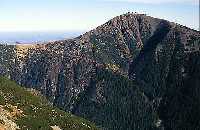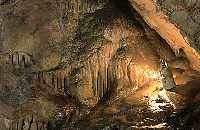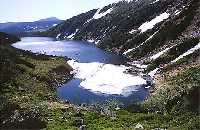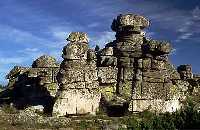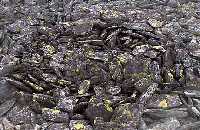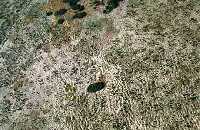
©2008 Mediapool
|
 Geology, geomorphology
 Shown as list
(found: 11 out of 95 records in category: Nature)
Ergis #ID: 20

Geological map
1) GRANITE
2) MICA SCHIST AND PHYLITE
3) GNEISS
4) SLATE
5) QUARTZITE
6) CRYSTALLINE CALCITE
Ergis #ID: 19

Granite
The major part of the Polish Giant Mountains and the whole main ridge from Harrachov to the Sněžka mountain consists of granite. In the Palaeozoic era, fervent granite magma insinuated into surrounding crystalline stale and formed a granite massif of up to 5 km thickness. Where the granite magma met carbon rocks the Giant Mountain's ore beds originated. (Obří důl, Svatý Petr, Malá Úpa).
Levelled, slightly curved peaks are typical for granite ridges.
Like other granite massifs the Giant Mountain granite is also disrupted by a system of cracks, which cause its typical decomposition into stone blocks (in the picture we can see stone blocks at Pančava waterfall). On the ridges we can find groups of rocks - so called tory where the erosion abraded sharp blocks into the shape of loafs.
Ergis #ID: 21

Crystalline slate (gneiss, mica schist, phylite,quartzite)
Crystalline slate (gneiss, mica schist, phylite,quartzite) is the most common rock in the Giant Mountains. It appeared in the Palaeozoic era some 500 million years ago. Enormous pressures and extreme temperatures re-melted original layers of sea sediments as well as volcanic lava into new rocks. Layered structure is typical for many kinds of crystalline slate.
Crystalline slate, unlike granite that crumbles into rock blocks, falls into fragments with very sharp edges. This is one of the reasons why crystalline slate ridges are much sharper and steeper. Also rocks present in ridge detritus are of different shapes due to the kind of rocks the particular ridge is formed of.
The inner Czech ridge with adjacent montane crotches and a part of the main ridge from Sněžka mountain to the East is formed of crystalline slate.
Crystalline slate is much more resistant to erosion than granite so the ridges formed of this rock are not so smoothed and slopes are much steeper. (Kozí hřbety, Obří hřeben, Sněžka,...).
Ergis #ID: 22

Calcite
In the mass of crystalline slate there appear insertions and lens of crystalline calcite and dolomites. These are mined at several places of the Giant Mountains (Černý Důl, Horní Lánov, Suchý důl, in the past also Strážné). After polishing they are used for facing (marble), for the production of lime etc. Small caves also appear in the calcite of the Giant Mountains.
<<< Now abandoned quarry in Strážné was once a source of demanded statuary marble.
Ergis #ID: 27

Caves
In the Giant Mountains there are more than twenty small caves, mostly at the East and South rim. They were formed in the past by flowing underground water in calcite layers. Many of them have no natural entry from the surface - they were discovered during calcite mining in quarries. Some have been probably waiting to be discovered until nowadays.
Considering size and stalactical decoration, The Giant Mountain caves can not be compared to Moravian Karst. Although we won't find here large underground rivers, there exist caves with deep underground lakes, which have not been satisfactorily explored yet. Stalactical decoration of the Giant Mountain caves is very poor. Trucovna Cave is an exception (see the picture 2).
In a close neighbourhood of the Giant Mountains we can find richly decorated Bozkovské Caves which are opened for public.
Ergis #ID: 25

Glacial Cirques
During the ice ages of Quarternary Era several glacial tongues appeared in the Giant Mountains.
Masses of ice "flowing" slowly down from the slopes abraded glacial cirques in upper parts and U-shaped valleys in lower parts (Valleys formed by rivers are V-shaped). In local terminology glacial cirques are called "pits" ("jámy").
Slowly flowing glacier pushed before it stones and detritus. It created piles of stones and detritus, which are called front or side moraines. After the glacier disappeared moraines remained. The front moraines sometimes locked the valley and the melted ice created glacial lakes. Glacial lakes can be found mostly on the Polish side of the Giant Mountains. In the Giant Mountains glacial lakes are marked with Polish expression "staw".
Ergis #ID: 26

Karling - Snezka
Sněžka mountain is an exception among all the Giant Mountain peaks. This mountain was ground into the shape of a sharp pyramid by glaciers that clung to it from three sides. A pyramid formed this way is called "karling".
Ergis #ID: 23

Tor
Isolated tower rocks called „tor“ are typical for the peak altitudes of the Giant Mountains as well as the slopes on the Polish side of the main ridge. They were formed during Secondary and Tertiary Eras when erosion caused weathering and loss of softer rocks and uncovered blocks of durable granite which were originally hidden deep under the surface. Uncovered granite rocks were then, as typical for granite, chopped mainly by frost into square blocks. These blocks then eroded into present loaf shapes.
In local terminology these tory are called "stones" - i.e. "Noon Stone" (see the picture 1), "Male Stones", "Girl Stones" (see the picture 2), "Harrach Stones", ...
Ergis #ID: 24

Stony polygons
During ice ages, frost erosion created stone and boulder seas on most of the highest Giant Mountain ridges. Even when standing on the ground, an open-eyed observer can notice almost circular formations of these stones and boulders - polygons. They were not created by any extraterrestrial civilisation but by frost.
Water between the stones repeatedly freezes and melts. Thus its volume changes regularly and water causes stones to be pushed from each other while selects bigger from the smaller ones. In the course of time regular polygonal formations appear. Frost pushes bigger stones away from the centre. On the border of two polygons the stones are pushed against each other and into unnatural upright position.
Some polygons consist only of stones, some have their centres filled by finer detritus or soil, which accommodate grass or small bushes.
Polygons on the slopes slide down due to gravity and soil creep, and stretch into irregular stripes and furrows.
Ergis #ID: 29

Waterfalls
The highest altitudes of the Giant Mountains serve as spring areas of several creeks and rivers. On their way to the valley they must overcome large superelevations and that is where waterfalls appear. The largest waterfalls can be found on the steep slopes of huge glacial valleys – Labský důl pit, Úpská jáma hole etc. The highest one (149 m) is a waterfall of the Pančava river on the edge of Labský důl pit.. The small Pančava river springs at Pačava peat moor (near the spring of Elbe river), falls down on the cascade of granite boulders to the valley bottom and finally join the river Elbe. Near the waterfall there is a tourist route with two view spots on it. In the surroundings of waterfalls we can find a large number of rare plant and animal species bound to the humid environment.
Ergis #ID: 28

Giant Pots
Evorsion is a kind of water erosion, which abrades rocky river-bed with wafted cobble stones and sand like with emery paper. Where the river-bad shape forms vortexes, water abrades circular wells called "giant pots". It is a common formation of the Giant Mountain streams and rivers.
During several millions of years of abrasion the giant pots reached extraordinary depths. Very large and nicely developed ones can be found in the Jizera river near Vilémov. Beautiful pots abraded in granite can be also seen in the Mumlava river near Harrachov.
|
Our tip
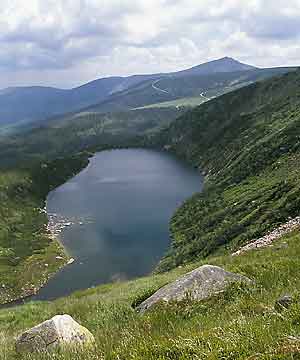
Our tip
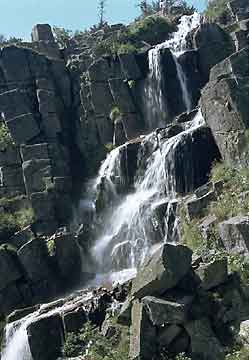 Špindlerův Mlýn
Špindlerův Mlýn
Our tip
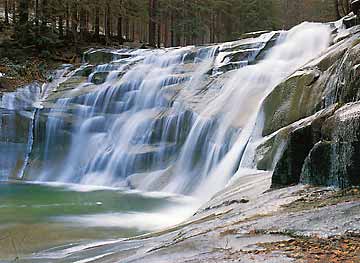 Harrachov
Harrachov
Our tip
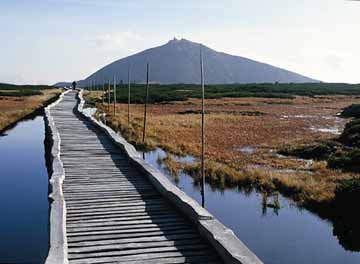 Pec pod Sněžkou
Pec pod Sněžkou
Our tip
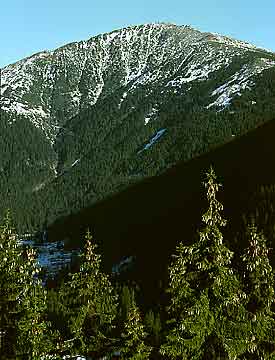 Pec pod Sněžkou
Pec pod Sněžkou
Our tip
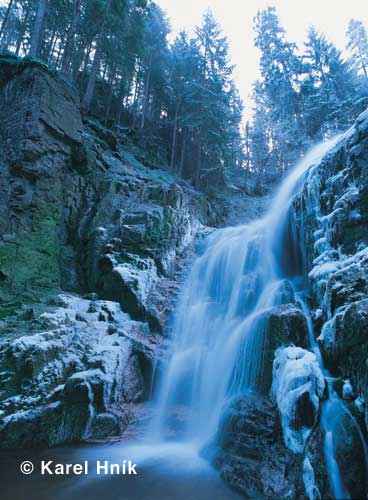
|







